Background: The development of better cross linked acrylic resin teeth has solved the problems related to wearing and discoloration of acrylic teeth. The same cross linking at ridge lap region acts as a double edge sword as it weakens the bond between denture base and tooth.
Aim of Study: The purpose of study was to evaluate the effect of surface treatment on the bond strength of resin teeth to denture base resin using monomethyl methacrylate monomer and dichloromethane with no surface treatment acting as control.
Settings and Design:Denture base cylinder samples in wax (n=180) were made with maxillary central incisor attached at 450 (JIST 6506). These samples were randomly and equally divided into three groups of 60 each. These specimens were then flasked, dewaxed as per the standard protocol.
Materials and Methods: Before acrylization, ridge lap area was treated as follows: Group A- no surface treatment act as control, Group B treated with monomethyl methacrylate monomer, Group C treated with dichloromethane. Digitally controlled acryliser was used for acrylization as per manufacturer’s instructions and shear bond strength was tested on Universal Testing Machine (Servo Hydraulic, 50kN High Strain, BISS Research).
Statistical Analysis used: Result was statistically analyzed with One-way analysis of variance (ANOVA) and Post-hoc ANOVA Tukey’s HSD test at 5% level of significance.
Results: The application of dichloromethane showed increased bond strength between cross linked acrylic resin teeth and heat cure denture base resin followed by monomethyl methacrylate monomer and control group.
Conclusion: The application of dichloromethane on the ridge lap surface of the resin teeth before packing of the dough into the mold significantly increased the bond strength between cross linked acrylic resin teeth and heat cure denture base resin.
Introduction
Heat-polymerized PMMA resin is used as a denture base material because of its excellent esthetics, low water sorption and solubility, relative lack of toxicity, repair ability, and simple processing technique [1] . Pre‑fabricated acrylic resin teeth for dentures were introduced in 1940. Since then, this material has become the most popular artificial material for denture teeth. Apart from economical advantage, it also bonds chemically to the denture base [2] . Debonding of denture teeth from denture bases is a major problem in the prosthodontic practice [3] . This problem is even more serious in implant-supported over dentures, because the superior chewing capacity increases the risk of displacement of the artificial teeth from the denture base [4] . This detachment may be attributed to the direction of stresses encountered during function; the most probable reason for failure is the crack propagation from areas of high stress concentration [5] .
Several studies have been carried to evaluate and study the compatibility of acrylic teeth to denture base resins. The surface modification on the ridge lap surface of acrylic resin teeth by the application of various chemicals before packing has shown variable results on the bond [6,7] .
Recently, the application of non-polymerizing solvents like dichloromethane, chloroform and adhesive bonding agent seem to enhance the bond strength between denture base resin and acrylic resin teeth [8-13] . Adeyemi et al., [12] stated that the chemical bonding between teeth and the polymer-monomer dough occurs through absorption of monomer by the surface layers of teeth. This monomer subsequently co-polymerizes with the denture teeth to form inter-penetrating polymer networks (IPN). Vallittu et al., [14] stated that lesser cross linking in polymer structure facilitates better bonding of the polymer tooth to the denture base. Hence, cross-linked polymer matrix is usually non evenly distributed in the tooth structure e.g. the ridge lap area may not be as highly crosslinked as the incisal area of the tooth. Patil SB [15] reviewed a variety of chemical surface treatments used to increase the bond strength of teeth to denture base resin including application of monomer (methyl methacrylate), an adhesive bonding agents and non polymerizable solvents like dichloromethane. With the above in mind, an in-vitro study was designed and conducted to compare and evaluate the effects of dichloromethane and monomethyl methacrylate monomer treatment on bond strength of acrylic resin teeth with denture base resin.
Materials and Methods
The investigation was carried out with a single investigator with a sample size of 180 acrylic resin teeth (Maxillary central incisor cross linked, Prestodent) attached to denture base resin (heat cure resin Trevalon; Dentsply, India). Differential surface treatment was done at the ridge lap area with Monomethyl methacrylate monomer (MMM) liquid (Dentsply, India) and Dichloromethane solvent (Qualigens Fine Chemicals). The samples were subjected to shear load in universal testing machine to evaluate the bond strength at the interface. The investigation was completed in one month time period.
For the purpose of the study, a two piece metal mold of 35 mm length and 12 mm diameter was fabricated to standardize the attachment of teeth at 450 using wax pattern. Care was taken to embed the tooth only up to the neck of central incisor into the wax cylinder [Table/Fig-1]. These dimensions confirmed to that of the jig attached to the universal testing machine. Japanese Standard for acrylic teeth (JIST 6506, 1989) was followed because of reliability as it utilizes single maxillary or mandibular anterior tooth for testing 16bond strength between denture base resin and acrylic resin teeth as debonding mostly occurs in the maxillary anterior teeth [16] .
180 such wax cylinders were obtained with the teeth attached at their respective positions. The wax samples were randomly divided and coded into three groups of 60 samples each. These 180 wax cylinder specimens were then flasked, dewaxed as per the standard protocol and Surface treatment of teeth was done as follows
Group ‘A’- The ‘Control’ group. (n=60) Ridge lap of each of the tooth was left untreated.
Group ‘B’- The ‘MMM’ group. (n=60) Ridge lap was painted with monomethyl methacrylate monomer using micro brush once and left for 3 min before packing.
Group ‘C’- The ‘DCM’ group. (n=60) Ridge lap was painted with Dichloromethane solvent once using micro brush applicator and left for 30 seconds before packing [17] .
The mold space was packed with conventional heat cure denture base resin (Trevalon; Dentsply, India) using dough method with Powder/liquid ratio of 3:1 by volume. Compressive pressure was applied under the hydraulic press. Trial closure was done using cellophane separating sheets followed by final closure and bench cure [18] . Polymerization was done in the digitally controlled acryliser (Dent Cure-Puneet industries, India) taking into consideration the manufacturer’s instruction.
The samples were retrieved from the flasks with the respective markings transferred for respective groups [Table/Fig-2]. The cross sectional area of each of the sample tooth was measured with the help of vernier caliper [Table/Fig-3] to feed the data in the computer for programming of the Universal Testing Machine (Servo Hydraulic, 50 kN High Strain, BISS Research) [Table/Fig-4] before subjecting the samples for testing under shear load. A shear load was applied to the incisal one third of the tooth to best simulate clinical forces on the maxillary central incisor at a crosshead speed of 0.6mm min and a load cell range of 1000 N until fracture occurred [Table/Fig-5] . Upon fracture, each sample was removed and the shear load applied (Newton, N) was recorded. The sheared specimens were also examined visually to determine the type of fracture at the fracture site [Table/Fig-6] [9] .
The statistical tests used were: One-way analysis of variance (ANOVA) and Post-hoc ANOVA Tukey’s HSD test at 5% level of significance to evaluate the significance of difference in applied shear load (Newton, N) to establish the superiority of surface treatments done over the control (without any surface treatment) as well as to compare the effect of two surface treatment amongst each other.
Wax cylinder with tooth in the metal mold
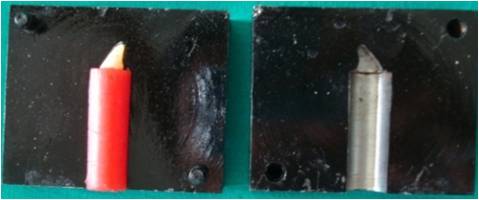
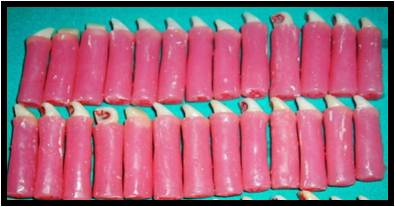
Digital Vernier Caliper Figure
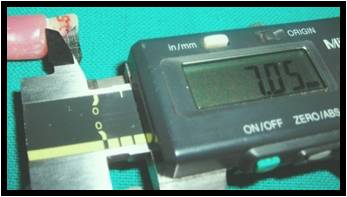
Universal Testing Machine
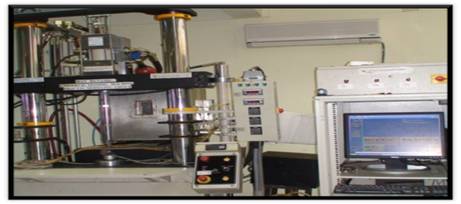
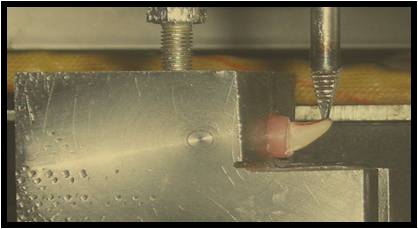
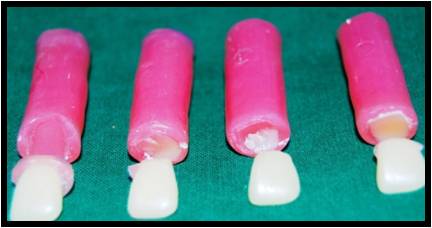
One way ANOVA for Shear Load of different groups
| Groups | N | Mean | S.D. | f-value | p-value |
| Control Group | 60 | 146.6228 | 16.96829 | | |
| Monomethyl methacrylate monomer | 60 | 173.0188 | 42.76075 | 23.429 | <0.0001 |
| Dichloromethane | 60 | 189.5572 | 38.55247 | | |
| Total | 80 | 169.7329 | 38.75374 | | |
| There was significant variation between all three groups, P<0.05 was significant, ANOVA=Analysis of variance; SD=Standard deviation |
|---|
Comparison of mean bond strength of Group A, B and C (Shear Load For Debonding)
| Groups | Control | Monomethyl methacrylate monomer | Dichloromethane |
| Control | | <0.05 | <0.05 |
| Monomethyl methacrylate monomer | | | <0.05 |
| Dichloromethane | | | |
| Tukey’s HSD0.05 = 3.18, P<0.05 was significant |
|---|
Pairwise comparisons via tukey’s HSD test
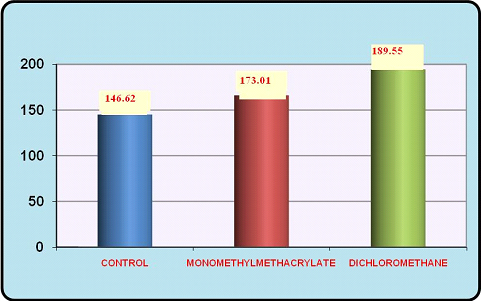
Results
Group A (Control, n=60) Minimum shear load was observed to be 117.67, maximum 181.15, standard deviation of 16.968 and mean of 146.622N
Group B (MMM, n=60) Minimum shear load was observed to be120.85, maximum 256.35, standard deviation of 42.760 and mean of 173.018
Group C (DCM, n=60) Minimum shear load was observed to be 131.35, maximum 278.57, standard deviation of 38.552 and mean of 189.557
Statistical analysis with One-way ANOVA [Table/Fig-7,8]. showed that mean difference between all the groups were statistically significant. Among all the three groups the lowest mean value of 146.622N was recorded for Group 1 (control group). The highest mean value, 189.557 was recorded for Group 3 (Dichloromethane group). Since there was statistically significant mean difference between all the groups, the Post‑hoc ANOVA Tukey’s HSD test was done for pairwise comparison between each groups and they also showed a significant difference [Table/Fig-9].
When pairwise comparison was done, Dichloromethane group was best (mean = 189.557N) followed by Monomethyl methacrylate monomer group (mean=173.018N), Control group (mean=146.622N) [Table/Fig-9].
For all the study specimens, the type of fracture was found to be cohesive.
Discussion
evaluate bond strength between denture base resin and acrylic resin teeth. These are ISO 3336 (1977), BS 3990 (1980), ANSI/ADA 15 (1985), DIN 13907 (1983) and JIST 6506(1989). We relied on JIST 6506(1989) as it is the latest test and utilizes single maxillary or mandibular anterior tooth for testing and debonding mostly occurs in the maxillary anterior teeth [16] .
Papozoglou E [8] reported that a wetting of 3 minutes with monomethyl methacrylate produced the strongest bonds in acrylic resin repairs whereas Sarac YS [17] studied denture repairs by painting the surface of denture base resin with dichloromethane as an etchant for 30 seconds. We took this into consideration in our study while treating the ridge lap area with monomethyl methacrylate and dichloromethane respectively.
In this study, specimen were subjected to a shear load applied palatally to the incisal 1/3rd of the tooth to best stimulate clinical forces on a maxillary incisor as shown by Zukerman GR [16] in his study until fracture occurred and failure load was recorded in Newton (N). The same was applied in our study using Universal Testing Machine (Servo Hydraulic, 50 kN High Strain, BISS Research).
Studies have reported that the use of solvents had improved the bond strengths [8,9] [10] . The efficacy of dichloromethane application in improving the bond strength of resin denture teeth to denture base resin was established in the study done by Chai John[9] using 60 conventional and 60 cross linked teeth with application of dichloromethane solvent. They reported a significant increase in the mean bond strength of 217 N over untreated teeth with mean bond strength of 120 N. Our study verified the same with (sample size of 180) significant increase in bond strength of Group C (mean bond strength 189 N) over the control Group A (mean bond strength 146N). Takahashi et al., [10] further deduced that the micro 17roughness created by dichloromethane- treatment on denture teeth surfaces increased the mechanical retention thereby improving the bond strength.
Our investigation also revealed that samples in Group B, showed enhanced mean bond strength (173N) when compared to Group A (mean bond strength 146N). This was contradictory with the study of Morrow et al., [19] . They concluded that painting the ridge lap of the teeth with monomer did not seem to improve the adhesion. According to them faulty boil out or contamination of the ridge lap area with separating media may be responsible for low bond strength values in some samples.
This was in accordance with Papozoglou E [8] who showed significant increase in bond strength when treated with monomethyl methacrylate monomer. Adeyemi [12] also concluded that priming the denture tooth surface with monomer liquid yielded significantly higher bond strength than other treatments. Papozoglou studied further the reason for this increased strength and came up with explanation that the application of monomer leads to swelling of the polymer and hence more penetration of monomer into the resin teeth resulting in strengthening of joint between denture teeth and the denture base resin [8] .
There was a significant improvement found in the mean bond strength of samples treated with dichloromethane in group C over monomethyl methacrylate treated samples in group B. Nagai et al., [20] stated that scanning electron microscope view of denture teeth surfaces treated with dichloromethane revealed pores, channels, superficial crack propagation as well as the formation of numerous pits approximately 2μm in diameter probably representing the spaces previously occupied by resin polymer. Such a surface topography suggests micromechanical retention as a mechanism to explain the advantage of dichloromethane in improving bonding.
In this study, a thin layer of white acrylic resin teeth was present on the denture base resin in group A. In group B and C it was distinctly noted that the fracture line always crossed some portion of the teeth as well as denture base could be suggesting that application of an external solvent may lead to a better penetration of the free monomer, resulting in a better bond strength. The other finding observed under visual examination was that all the fractures at the interface of the sheared specimens appeared to be cohesive in nature. This was in accordance with Fletcher-Stark et al.,[21] when a bonding agent was used with light- and heat-polymerized denture base resins, mixed and cohesive failures were observed. Cohesive failure occurs if there is a presence of any trace denture base resin on the surface of the denture tooth or remnants of the denture tooth on the denture base. Adhesive failure occurs if there is no trace of any denture base resin on the tooth surface after the fracture [9] . Further scanning electron microscopic studies can be done to verify the type of fractures
Limitations of study
One limitation of this study lies with difference in testing the shear bond strength in vivo compared to in vitro.
Conclusion
There has been a great advancement in the technology and material science of complete denture prostheses for edentulous patients. This has led to complete denture prostheses which are more aesthetic and have better strength. The development of better cross linked acrylic resin teeth has solved the problems related to wearing and discoloration of acrylic teeth. The same cross linking acts as a double edge sword in the matter of bonding between denture base material and teeth, as more the cross linking at ridge lap region weaker the bond between denture base and tooth. Our attempt evaluated the effect of surface treatment of acrylic resin teeth using monomethyl methacrylate monomer and dichloromethane on the bond strength of resin teeth to denture base resin. The application of dichloromethane on the ridge lap surface of the resin teeth before packing of the dough into the mold significantly increased the bond strength between cross linked acrylic resin teeth and heat cure denture base resin.
[1]. MS Memon, N Yunus, AA Razak, Some mechanical properties of a highly crosslinked, microwave-polymerized, injection-molded denture base polymer. Int J Prosthodont. 2001 14:214-8. [Google Scholar]
[2]. HP Thean, CL Chew, KI Goh, Shear bond strength of denture teeth to base: A comparative study. Quintessence Int. 1996 27:425-8. [Google Scholar]
[3]. F Bahrani, AAR Khaledi, Effect of surface treatments on shear bond strength of denture teeth to denture base resins. Dental Research Journal. 2014 11(1):114-118. [Google Scholar]
[4]. G Saavedra, LF Valandro, FP Leite, R Amaral, Bond strength of acrylic teeth to denture base resin after various surface conditioning methods before and after thermocycling. Int J Prosthodont. 2007 20:199-201. [Google Scholar]
[5]. A Prombonas, D Vlissidis, Effects of position of artificial teeth and load levels on stress in the complete dentures. J Prosthet Dent. 2002 88:415-22. [Google Scholar]
[6]. VP Krishna, A Premalatha, PJ Babu, DS Raju, MP Kumar, DB Rao, Effect of various chemicals on the bond strength of acrylic tooth and denture base -An Invitro comparative study. Journal of International Oral Health. 2014 6(1):100-05. [Google Scholar]
[7]. JL Cunningham, Bond strength of denture teeth to acrylic bases. J Dent. 1993 21:274-80. [Google Scholar]
[8]. E Papozoglou, AI Vasilas, Shear bond strengths for composite and autopolymerised acrylic resins bonded to acrylic resin denture teeth. J Prosthetent. 1999 82:573-78. [Google Scholar]
[9]. J Chai, Y Takahashi, T Takahashi, T Habu, Bonding durability of conventional resinous denture teeth and highly crosslinked denture teeth to a pour- type denture base resin. Int J Prosthodont. 2000 13:112-16. [Google Scholar]
[10]. Y Takahashi, J Chai, T Takahashi, T Habu, Bond strength of denture teeth to denture base resins. Int J Prosthodont. 2000 13:59-65. [Google Scholar]
[11]. JL Cunningham, Shear bond strength of resin teeth to heat-cured and light cured denture base resin. J Oral Rehabil. 2000 27:312-16. [Google Scholar]
[12]. AA Adeyemi, MF Lyons, DA Cameron, The acrylic tooth- denture base bond: effect of mechanical preparation and surface treatment. Eur J Prosthodont Rest Den. 2007 15:108-14. [Google Scholar]
[13]. G Nishigawa, Y Maruo, M Okamoto, OKI Kazurhio, Y Kinuta, Effect of adhesive primer developed exclusively for heat- curing resin on adhesive strength between plastic artificial tooth and acrylic denture base resin. Dent Materials J. 2006 25():75-80. [Google Scholar]
[14]. PK Vallittu, IE Ruyter, The swelling phenomenon of acrylic polymer teeth at interface with denture base polymers. J Prosthet Dent. 1997 78:194-99. [Google Scholar]
[15]. SB Patil, BH Naveen, NP Patil, Bonding acrylic teeth to acrylic resin denture bases: a review. Gerodontology. 2006 23:131-39. [Google Scholar]
[16]. GR Zukerman, A reliable method for securing anterior denture teeth in denture bases. J Prosthet Dent. 2003 89:603-07. [Google Scholar]
[17]. YS Sarac, D Sarac, T Kulunk, S Kulunk, The effect of chemical surface treatments of different denture base resins on the shear bond strength of denture repair. J Prosthet Dent. 2005 94:259-66. [Google Scholar]
[18]. KJ Anusavice, Phillip’s Science of Dental Materials. 2004 11th EditionUSASaunders Co. [Google Scholar]
[19]. RM Morrow, FM Matvias, AS Windeler, RJ Fuchs, Bonding of plastic teeth to two heat-cured denture base resins. J Prosthet Dent. 1978 39:565-68. [Google Scholar]
[20]. E Nagai, K Otani, Y Satoh, S Suzuki, Repair of denture base resin using woven metal and glass fiber: effect of methylene chloride pretreatment. J Prosthet Dent. 2001 85:496-500. [Google Scholar]
[21]. ML Fletcher-Stark, KH Chung, JE Rubenstein, AJ Raigrodski, LA Mancl, Shear bond strength of denture teeth to heat- and lightpolymerized denture base resin. J Prosthodont. 2011 20:52-9. [Google Scholar]